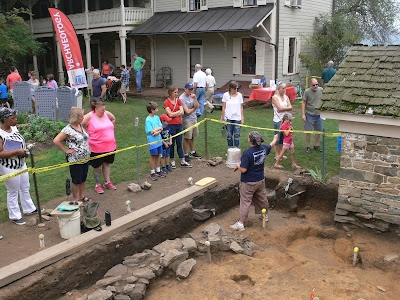Anthropomorphic renditions in
various media are well represented in the archaeological assemblages of the
world, from Paleolithic times to the present. There is something about the appearance
of the sculpted, modeled or carved human face on the collar of a pot, the bowl
of a tobacco pipe or, perhaps, a pocket talisman, that conveys the phrase ---
speak to me!
Figure 1. Pine
Island “rock face”, Late Archaic period
Human face-like images have been
recovered from archaeological contexts in Pennsylvania going back in time to
the Late Archaic period. The “face rock” from Piney Island (Figure 1) may be
4000 years old as it was found between soil strata with radiocarbon dates of 3720
BP. and 4000 BP. (Kent 1996). In the Upper Delaware Valley, similar faces were apparently
pecked onto the surfaces of small cobbles during the Late Woodland period. Stylized
faces were also carved onto small pebbles and, the interior beam posts of the
Oklahoma Delaware Big House or Xingwikaon.
These carvings in bold relief may be Lenape renditions of the Mesingw or Masked Being. The Ohtas, or “Doll Beings” with remarkable
powers (Figure 2), used in the Doll Dance by the Oklahoma Delaware were also carved from wood in precise detail (Kraft
2001).
Figure 2. Wooden
Ohta doll, Delaware 19th century
The Munsee, who occupied a large
part of the Delaware Valley from Port Jervis south to the Water Gap, decorated
their cooking and storage pots with human-face-like features. Typically, three
punch marks, made with a blunt stylus carved from wood or bone, formed the eyes
and mouth and these were located at each rim castellation (Figure 3).
Figure 3. Munsee
face pot, probably 17th century
Occasionally the potter chose to sculpt one face above the other. In the Lower
Susquehanna Valley, these human face-like renditions became very common appliques
to the collars of Susquehannock pottery by the first quarter of the 17th
century (Figure 4). Susquehannock face pots were used for the storage and
cooking of foods and as receptacles for burial offerings that held one last
meal for the deceased.
Figure 4. Susquehannock
face pot. Early 17th century
In both the Delaware and Susquehanna
valleys, charm stones were made and carried by the Lenape and Susquehannock
people. Principally made of soft stone such as steatite, serpentine, siltstone
and by the middle of the 18th century, red pipestone (Figure 5),
these effigies like the wooden Ohtas,
were carved with great detail.
Figure 5. Pipestone
maskette. Conestoga Indian site. Mid-18th century
Human face-like images adorned the
bowls of tobacco pipes of the different Native American cultures. Certain clay pipes
of the Wyoming Valley Complex (Smith 1973) are characterized by pronounced eye
and mouth features indicative of some northern Iroquoian false face masks (Figure 6).
Figure 6. Wyoming
Valley clay face pipe. Early 15 century
Some of these mimic Onondaga and Mohawk pipe styles attributed to
the Early Iroquois Chance phase dates to
approximately 1375-1425 A.D. Our Pennsylvania examples appear to be confined to
the North Branch of the Susquehanna River from Nanticoke to the New York State
line. Several pipe styles from southern Ontario suggest contact between the
Wendat and Susquehannocks in the early to mid-17th century. Examples
of the pinched face or plague pipe, a late 16th to early 17th
century form, are rare in Susquehannock material culture but common in southern
Ontario (Figure 7).
Figure 7. Pinch
face clay pipe. Huron/Susquehannock Early 17th century
These pipes which depict
the gaunt forlorn image of a human are so-named for the illnesses brought by
Europeans that ravaged North American native societies.
Figure 8. Face
pipe of stone. Warren County, Pennsylvania. Age unknown
Moving our discussion westward we
note the vasiform-shaped pipe of fine grained siltstone from a Seneca site in
the Upper Allegheny valley. With a pronounced blowing or whistling mouth, boldly
shaped brows and deep-set eyes, the image mimics the “Blower” category of false
face masks used by the Iroquois or Haudenosaunee
in their Mid-Winter ceremony (Figure 8). Another, stone face though much less
expressionless, is from a site on the Sinnemahoning drainage in west-central
Pennsylvania. Carved from fireclay, a soft indurated clay stone, the image has
neither eyes nor mouth giving the object an expressionless appearance suggesting
that it is an unfinished piece that was lost or discarded by its owner (Figure
9).
Figure 9. Stone
maskette. Sinnemahoning Valley. Age unknown
Anthropomorphic images whether
modeled or carved, onto pots, pipes or rocks take Native American material expression
to its highest level that only the artisans who made these objects might truly understand
their meanings --- speak to me!
Bibliography:
Harrington, Mark R.
1921 Religion and Ceremonies of the
Lenape.Museum of the American Indian, Heye Foundation Indian Notes and Monographs 19.
Kent, Barry C.
1996 Piney Island and the Archaic of
Southeastern Pennsylvania, Pennsylvania
Archaeologist 66(2); 1-42.
Kraft, Herbert C.
2001 The Lenape-Delaware Indian Heritage: 10,000
BC to AD 2000. Lenape Books.
Smith, Ira F.
1973 The Parker Site: A Manifestation of the
Wyoming Valley Culture. Pennsylvania
Archaeologist 43(3-4): 1-56.
Speck, Frank G.
1931 A
Study of the Delaware Big House Ceremony. Publications of the Pennsylvania
Historical Commission, Volume II, Harrisburg.




















